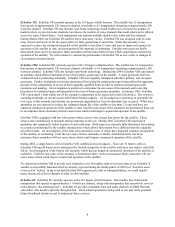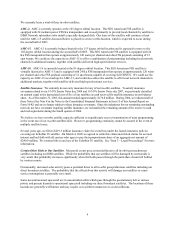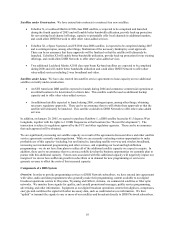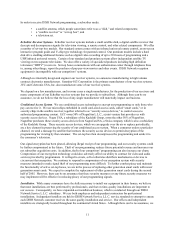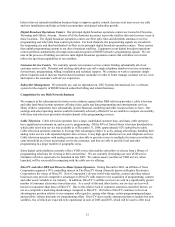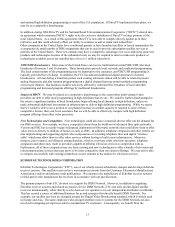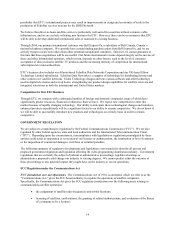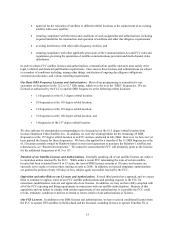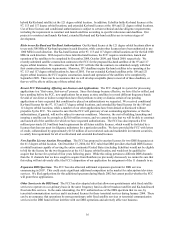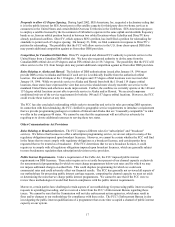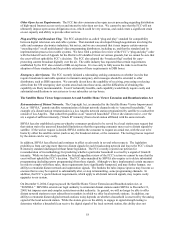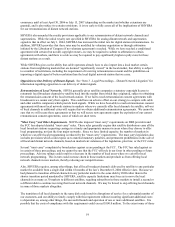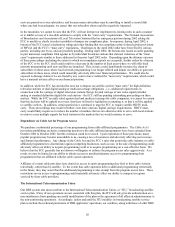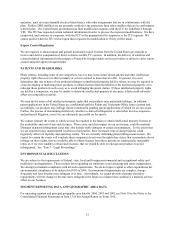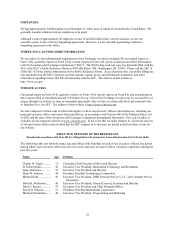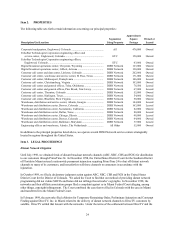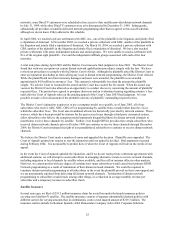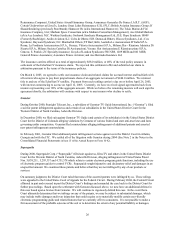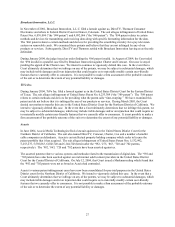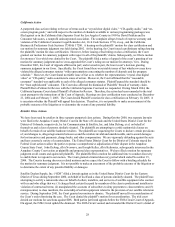Dish Network 2004 Annual Report Download - page 26
Download and view the complete annual report
Please find page 26 of the 2004 Dish Network annual report below. You can navigate through the pages in the report by either clicking on the pages listed below, or by using the keyword search tool below to find specific information within the annual report.18
Other Open Access Requirements. The FCC has also commenced an open access proceeding regarding distribution
of high-speed Internet access services and interactive television services. We cannot be sure that the FCC will not
ultimately impose open access obligations on us, which could be very onerous, and could create a significant strain
on our capacity and ability to provide other services.
Plug and Play and Broadcast Flag. The FCC adopted the so-called “plug and play” standard for compatibility
between digital television sets and cable systems. That standard was developed through negotiations involving the
cable and consumer electronics industries, but not us, and we are concerned that it may impose certain onerous
“encoding rules” on all multichannel video programming distributors, including us, and that the standard and its
implementation process favor cable systems. We have filed a petition for review of the FCC’s “plug and play” order
with the federal Court of Appeals for the District of Columbia Circuit on various grounds, but we cannot be sure that
the court will not uphold the FCC’s decision. The FCC also adopted the “broadcast flag” method for copy-
protecting content broadcast digitally over the air. The cable industry has requested that certain requirements
established by the FCC also extend to DBS set-top boxes. It is too early to fully assess the risks to us from the
adoption of these standards and the possible extension of these requirements to DBS boxes.
Emergency Alert System. The FCC recently initiated a rulemaking seeking comments on whether its rules that
require broadcasters and cable operators to transmit emergency alert messages should be extended to other
distributors, such as DBS operators. We currently do not have the capability of receiving, processing or relaying
alerts from the 550 emergency alert system areas back into those areas, and the difficulties of obtaining this
capability are likely insurmountable. Even if technically feasible, such capability would likely require costly and
substantial modifications to our system or to our subscriber set-top boxes.
The Satellite Home Viewer Improvement Act and Satellite Home Viewer Extension and Reauthorization Act
Retransmission of Distant Networks. The Copyright Act, as amended by the Satellite Home Viewer Improvement
Act, or “SHVIA,” permits satellite retransmission of distant network channels only to “unserved households.” An
example of a distant station retransmission is a Los Angeles network station retransmitted by satellite to a subscriber
outside of Los Angeles. That subscriber qualifies as an “unserved household” if he or she cannot receive, over the
air, a signal of sufficient intensity (“Grade B” intensity) from a local station affiliated with the same network.
SHVIA has also established a process whereby consumers predicted to be served by a local station may request that
that station waive the unserved household limitation so that the requesting consumer may receive distant signals by
satellite. If the waiver request is denied, SHVIA entitles the consumer to request an actual test, with the cost to be
borne by either the satellite carrier (such as us), the broadcast station, or the consumer. The testing process required
by the statute can be very costly.
In addition, SHVIA has affected and continues to affect us adversely in several other respects. The legislation
prohibits us from carrying more than two distant signals for each broadcasting network and leaves the FCC’s Grade
B intensity standard unchanged without future legislation. The FCC recently rejected our petition for
reconsideration of its methodology for predicting whether a particular household is served by a signal of Grade B
intensity. While we have filed a petition for federal appellate review of the FCC’s action we cannot be sure that the
court will not uphold the FCC’s decision. The FCC rules mandated by SHVIA also require us to delete substantial
programming (including sports programming) from these signals. Although we have implemented certain measures
in order to comply with these rules, these requirements have significantly hampered, and may further hamper, our
ability to retransmit distant network and superstation signals. The burdens the rules impose upon us may become so
onerous that we may be required to substantially alter, or stop retransmitting, some programming channels. In
addition, the FCC’s sports blackout requirements, which apply to all distant network signals, may require costly
upgrades to our system.
On December 8, 2004, Congress passed the Satellite Home Viewer Extension and Reauthorization Act, or
“SHVERA.” SHVERA extends our legal authority to retransmit distant stations under SHVIA to December 31,
2009, but imposes new and complex restrictions on that authority. In general, we will no longer be able to offer
distant network stations to new subscribers in markets in which we offer local network stations. In addition, our
ability to retransmit distant digital network stations today depends on whether a household is unserved by the analog
signal of the local network station. While the statute gives us the ability to engage in signal strength testing to
determine whether a household can receive the digital signal of the local network station, this ability does not


